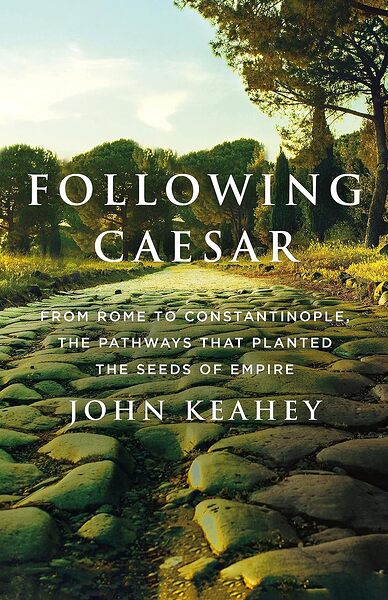Looking for a good read? Here is a recommendation. I have an unusual approach to reviewing books. I review books I feel merit a review. Each review is an opportunity to recommend a book. If I do not think a book is worth reading, I find another book to review. You do not have to agree with everything every author has written (I do not), but the fiction I review is entertaining (and often thought-provoking) and the non-fiction contain ideas worth reading.
Book Review
Tracing the Paths of Empire
Reviewed by Mark Lardas
January 14, 2024
“Following Caesar: From Rome to Constantinople, the Pathways That Planted the Seeds of Empire,” by John Keahey, St. Martin’s Press, December 2023, 256 pages, $30.00, (hardcover), $14.99 (e-book)
One of Rome’s enduring achievements was its Roman road system. They remain the basis of Europe’s road system over the portions of Europe once ruled by Rome. While many have been paved over, some original portions still exist today.
“Following Caesar: From Rome to Constantinople, the Pathways That Planted the Seeds of Empire,” by John Keahey, follows Roman roads. Part travelogue, part ancient history, part current events and part philosophical musing, it explores Roman history through its roads.
Keahey follows three Roman roads across Italy, the Macedonian Republic, Greece, and Turkey in the post-Covid Europe of 2021. The journey takes him along the routes of Via Appia in southern Italy, Via Egnatia in the Balkans to Istanbul, and then up Via Traiani along Italy’s Adriatic shore. He explores why the roads were built, the history that occurred on each road, and their present-day appearance today.
He opens by recreating a diplomatic mission the Roman poet Horace made for Octavian between 40 and 37 BC. Keahey follows the Via Appia, the first Roman road, from Rome to Ariccia. Keahey, traveling by automobile, traces the route Horace took, using roads as close to the one Horace traveled, making the same stops as Horace. Keahey describes both Horace’s ancient experiences and Keahey’s contemporary ones, while describing changes between ancient and modern times.
Keahey uses this template for the rest of the book. He travels down a part of each road using an ancient trip as a template for his wanderings. He examines the ancient traveler, his motivations, and what happened along the way. He then describes his own experiences and the people he meets during his travels. All the while he explores contrasts with and similarities to the ancient experience with his 21st Century experiences.
He follows Pompey Magnus to Brusindium, Julius Caesar and across Macedonia to fight his opponents at Pharsalus, and Octavian and Marc Antony along the Via Egnatia where they do battle against Julius Caesar’s assassins. He trails Cicero up the Via Traiana. Along the way he explores archeology as well as history, seeking out unchanged portions of these roads.
“Following Caesar” is a delightful book to read. Keahey brings the past to life, doing an impressive compare and contrast between the ancient road and his own experiences. Along the way he shows the continuing relevance of Ancient Rome to modern Europe. His storytelling is imaginative, compelling and factual, a rare combination.
Mark Lardas, an engineer, freelance writer, historian, and model-maker, lives in League City. His website is marklardas.com.
